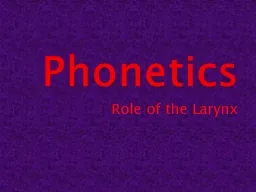

The larynx is a structure houses the vocal folds and made of cartilages The front wall is the thyroid cartilage or shield cartilage responsible for the Adams apple the thyroid prominence and which is located at the front of the neck ID: 779694
Download The PPT/PDF document "Phonetics Role of the Larynx" is the property of its rightful owner. Permission is granted to download and print the materials on this web site for personal, non-commercial use only, and to display it on your personal computer provided you do not modify the materials and that you retain all copyright notices contained in the materials. By downloading content from our website, you accept the terms of this agreement.
Slide1
Phonetics
Role of the Larynx
Slide2The larynx is a structure houses the vocal folds and made of cartilages. The front wall is the thyroid cartilage
, or ‘shield cartilage’ , responsible for the ‘Adam’s apple’ (the thyroid prominence) and which is located at the front of the neck.
Behind the thyroid prominence, on the inner surface of the cartilage is the anchor point for the front ends of the vocal folds.The thyroid cartilage is located at the top of the trachea (wind pipe) and controls the flow of air.The very top cartilage is a complete circle and is known as the cricoid cartilage or ‘ring cartilage’
What is the Larynx?
Slide3The vocal folds are fleshy folds of tissue, they are attached at the front the thyroid cartilage and are effectively hung like a pair of very substantial curtains across from the front to back of this structure. Muscles attaching to the aretynoid
cartilages are the main force for positioning the folds in an open (abducted) or closed (adducted) position. When open, the space between the folds is called the glottis.
The Vocal Folds
Slide4The interaction between the vocal folds and the egressive pulmonic
airstream are responsible for phonation, the sound source which is termed voice in speech.
Sounds can’t be produced without air coming from the lungs.The airstream comes from the lungs and goes the vocal tract The vocal tract consists of: the trachea, the larynx, supraglottal cavities (the cavities above the glottis), the pharynx, the oral cavity, and the nasal cavity. The
egressive
pulmonic
airstream
Slide5Normal voice is the result of the vocal folds vibrating in a particular way.This happens, as soon as the speaker has inhaled, the aretynoid
cartilages draw the folds (and themselves) together, then they are opened by the pressure of air which is expelled from the lungs, which is strong enough to push the vocal fold apart to produce voice.
They are closed again after the pressure escapes.They repeat on average 100–120 times per second for adult male voices and 200–240 times per second for adult female voices. In children, it can be 300 times per second. We hear this as pitch when we listen to speech, and deliberately varying the rate of vibration of our vocal folds makes our voices go up and down in pitch, adding intonation. Basically, the faster the rate of vibration, the higher the pitch of the voice.
Normal Voice
Slide6It is the result of an extremely low pitch voice.For some speakers of English, creaky voice is part of their idiolect. Some speakers tend to cultivate a very ‘creaky’ way of speaking, female speakers of American English.
Americans refer to this sound as glottal fry and the quality is sometimes an indicator of social status.
The big differences between creaky voice and normal voice are that the vibratory cycles tend to be irregularly spaced in creaky as opposed to regular in normal voice and that the frequency is always very low.Creaky voice/ Vocal, Glottal Fry/
Slide7Creaky voice is used in some African dialects to distinguish meanings of wordsSimilarly, creaky voice is also used in Danish where it is responsible for the linguistic characteristic known as
stød
in which a short interval of creaky voice affects the end of certain longer vowel sounds or sonorant consonants when they follow shorter vowels. Sonorant consonants are typically those which appear as ‘voiced only’ entries in the IPA chart (m-sounds, n-sounds, l-sounds, vowels, etc.).
Slide8Whispering and sighing are forms of breathiness, but these are also voiceless.To achieve this effect, the aretynoids draw the folds together, closing the folds themselves firmly, so that they resist the pressure from the
egressive
pulmonic airstream, but maintaining a gap between the two cartilages to enable the air to escape continuously at this point. Breathy voice is produced when the closure of the folds is less firm and the airstream not only escapes continuously between the open aretynoids, but also sets the folds vibratingIt is mostly used in/h/ sound and when someone is out of breath.
Breathy voice
Slide9The glottis can be a place of articulation as well sounds made by the glottis are called glottal, /h/.
To produce this voiceless variant, a different setting is required in which the folds and
aretynoids are drawn near to each other, but not touching, leaving a very small space between them such that as the egressive pulmonic air forces its way through, it becomes turbulent or ‘disordered’ and makes an h-sound.Another sound is produced in the larynx, is the glottal stop [ʔ] found in London Englishes mostly known as
t-
glottalling
THE LARYNX AS A PLACE OF ARTICULATION
Slide10Lexical use of pitch: there are many languages that use pitch to make distinctions in meanings of words, these known as tone languages. In a language like English, pitch changes map over a longer phrase (called the intonational
phrase). Here, a falling tone \
car gives the listener the impression of a statement (it is a car) while a rising tone /car is more likely to be interpreted as a question (is it a car?).The same syllable spoken with a mid tone >car sounds as if the utterance is incomplete (maybe the speaker forgot what they were going to say next), and so on.THE LARYNX AS A PITCH MODULATOR
Slide11VOICE AND THE IPA CHART